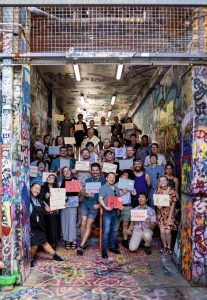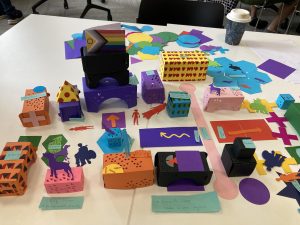2024.Mar.22
REPORTSReport on the Participation in HISS (the Hunt-Simes Institute in Sexuality Studies) 2024
Kyoko Takeuchi (Project Assistant Professor of the B’AI Global Forum)
・Date: February 19 – March 1, 2024
・Venue: University of Sydney
・Language: English
・Organizer: Hunt-Simes Institute in Sexuality Studies at University of Sydney

HISS (the Hunt-Simes Institute in Sexuality Studies), held in Sydney from February 19 to March 1, 2024, coinciding with the LGBTQ+ celebration of Mardi Gras, brought together over 40 queer scholars from various disciplines for an experimental workshop. The workshop was facilitated by Drs. Lee Wallace and Victoria Rawling. HISS explored the queer-led classroom with a focus on embodied learning and knowledge construction. Participants came from a variety of countries and regions, particularly English and Spanish speaking countries, and many queer researchers and practitioners presented experimental teaching that rethought existing education in schools. From the B’AI Global Forum, Drs. Yuko Itatsu and Kyoko Takeuchi participated in HISS. As a lecturer, Dr. Itatsu discussed gender bias in AI use and how AI can be opened up to queer possibilities.
The theme of this year’s HISS was Queer Relationality. Various topics such as intimacy, history, media, games, AI, and space are involved in the classroom environment as each class showed. Given this, it should be possible to situate the relationships among various categories in the context of learning and teaching in schools, and to consider the possibilities for inclusive education where queer friendships, community, and emotions are enabled. With these expectations, a two-week workshop was organized, based on a two-hour class in the morning and a two-hour class in the afternoon, with occasional field trips.
By participating in HISS, we were first able to learn through interaction with participants from different backgrounds how different situations exist in each of the class topics. For example, we learned many things about the educational settings with a religious background, such as the fact that some schools only teach abstinence as sex education. It was also interesting to have the opportunity to explore queer possibilities across disciplines, such as the class on entrepreneurs, while learning the current state of hierarchical sexual violence in the corporate setting. The work of considering the activities to be done as education for students, while considering the costs, led us to think about the intersectionality of business and profit, areas that have not been much explored because of their seeming incompatibility with the activities of education and research.
In the discussions, I was struck by the number of occasions on which personal experiences were also shared. For example, the initial orientation began with a group presentation of personal gifts, followed by classes in which questions were asked about how they had used AI, what they had learned in sex education, and what physical education had been like for them. In particular, in the “Critical Karaoke” class, participants were asked to relate themselves and their research interests to the personally chosen song. The fact that participants were engaged in some form of research or activism related to gender, sexuality, or queerness helped them expect each other’s understanding that they were speaking from the premise that there were gender and sexual minorities in the classroom. Of course, each of us had different experiences under different backgrounds, but there were aspects of our experiences that resonated with each other in a society that tends to take cisgender and heterosexual people for granted. This was also an opportunity to confront individual oppressive experiences in the classroom and try to recapture them by sharing them with other participants.
In addition, by working together in the classes, we learned what practices could be implemented to prevent the teacher-student relationship from becoming static in educational settings. For example, in some classes we discussed what kind of interaction is possible that goes beyond the simple relationship of the teacher giving a lecture and the students listening. I came to HISS with an expectation of what I could bring back to the field of educating students and faculty in Japan, but the difficulties in Japan seemed so far from the practice in HISS that it was difficult to think about how to make the most of them. For example, it is difficult to expect active interaction between teachers and students in a situation where few students are willing to raise their hands to express their opinions because they are afraid to visualize the differences between themselves and others, even in universities. However, when these situations were shared during the group work, the participants discussed how to start by discussing easily answerable questions, such as what was for breakfast today, in order to be able to express their own opinions. This discussion about educational practices that consider cultural differences in situations was an important experience especially when I think of the education in Japan.
 The HISS classes basically required the ability to listen and discuss in English in a group setting, but some of the classes were open to interaction that was not necessarily limited to speaking and listening. For participants who were born and raised in non-English speaking countries and do not normally use English, including myself, it was sometimes difficult to keep up with the fast pace of native English speakers. On the other hand, Dr. Xavier Ho’s “Queer Design” class, for example, allowed participants to work in groups to imagine what a queer school would look like through a combination of colored paper crafts and written descriptions, and Drs. Susan Potter and Amy Villarejo’s film class also included a pairing of two students who were asked to create a film in which they were asked a question and then made a film on the spot. Even in the wrap-up class on the last day, each person had a card with a question on it, and the pairs kept asking each other questions, exchanging cards, and looking for the next person to ask, allowing them to learn more about each other’s ideas on an individual basis rather than on a group basis. The fact that there were several classes that engaged in different levels of interaction, open to more physical and written expression, seemed important in considering more inclusive classes.
The HISS classes basically required the ability to listen and discuss in English in a group setting, but some of the classes were open to interaction that was not necessarily limited to speaking and listening. For participants who were born and raised in non-English speaking countries and do not normally use English, including myself, it was sometimes difficult to keep up with the fast pace of native English speakers. On the other hand, Dr. Xavier Ho’s “Queer Design” class, for example, allowed participants to work in groups to imagine what a queer school would look like through a combination of colored paper crafts and written descriptions, and Drs. Susan Potter and Amy Villarejo’s film class also included a pairing of two students who were asked to create a film in which they were asked a question and then made a film on the spot. Even in the wrap-up class on the last day, each person had a card with a question on it, and the pairs kept asking each other questions, exchanging cards, and looking for the next person to ask, allowing them to learn more about each other’s ideas on an individual basis rather than on a group basis. The fact that there were several classes that engaged in different levels of interaction, open to more physical and written expression, seemed important in considering more inclusive classes.
Moreover, queer relationalities are not only learned in the classroom; the lively interactions at HISS also provided an opportunity to reflect on their experiences in Sydney outside of HISS. Each of us learned about Australian history through museum and art museum exhibits and attended a variety of LGBTQ-related events in museums, art galleries, bars, and other venues in the city of Sydney before Mardi Gras. We learned as we walked that there are many queer-themed archives and bookstores, and that the entire city has created a welcoming LGBTQ atmosphere with flags of various sexualities painted on the walls. We shared and discussed our experiences with other participants, deepening our understanding and becoming aware of new events and exhibits. In particular, the wide-ranging exhibits at Qtopia, Sydney’s first LGBTQ history and culture museum, were impressive as a result of people’s ongoing struggles with gender norms in Australia and the fruit of a well-developed archivist structure that is working with other museums. HISS is situated on such a history of relationships around diverse sexuality and race/ethnicity in Sydney. I would like to bring my classroom experience at HISS and the rich network of participants from various backgrounds to bear on how we can find queer relationships in the classroom, and how we can use AI ethically including diverse relationships with each other in Japan.